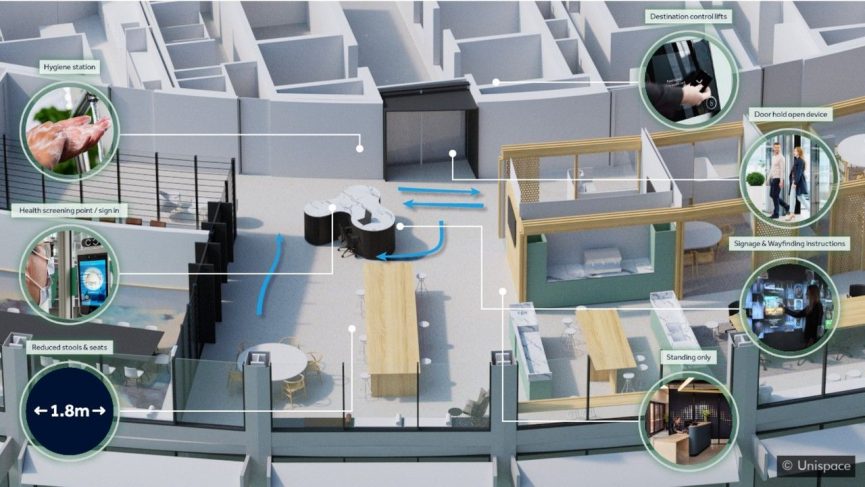Pandemic-proofing offices could involve short-term fixes, new working patterns and long term design upgrades that put hygiene at the heart of workplace planning.
As many nations cautiously make their way to relaxing Covid-19 lockdowns one area that will come under particular scrutiny is the office workplace where social distancing measures are often difficult to maintain, and workers are often in close proximity to each other – for instance in lifts, passing through corridors or at co-working desks.
Yet, in the absence of a vaccine, aspects of modern workplaces will have to change if employees are to safely return to their desks. Experts suggest this could involve a combination of short-term fixes aimed at boosting worker confidence, reducing the number of staff in the office at any one time and longer-term design upgrades and modifications that put hygiene at the heart of workplace planning.
After emerging from self-isolation, employees will be hyper alert about hygiene and density issues, and, workers will expect global standard safety measures to be in place when they return to the office.
Greater health & safety measures
There’s going to have to be a complete redesign of some office areas such as co-working spaces which focus on people getting together, maximising collaboration and community. Now it’s about redesigning for safety and providing enough space, while making sure workers can collaborate in other ways.
Most office providers implemented WHO guidelines at the start of the pandemic, but we believe workers will want to go further to ensure their personal safety by combining private offices or enclosed work zones with larger desks in shared working areas where there’s more control over who they interact with.
Sneeze guards the new normal
The ‘sneeze guard’, an additional panel fitted between socially distanced desks is a low-cost, high-impact measure. Previously, workstations were about privacy and acoustics. Now they represent a physical separation between colleagues. Until we hopefully have a vaccine, having that physical barrier will make people feel more comfortable.
Other safety measures suggested by the industry include:
- Increasing the size of desks from 1.4 meters to 1.8 or two metres wide, making it easier to observe the six feet rule.
- Using disposable paper placemats for co-workers to put under laptops.
- Installing air filtration and ventilation systems.
- Installing thermal imaging systems to check the temperature of colleagues.
- Zoning areas to make it easier to social distance and creating one-way traffic systems around the office to minimise transmission of the virus.
- Limiting the number of people in the office at one time.
- Improving smart technology that limits the need for touching the building. Tech could also be used to track employees’ movements and notify them when the sic-feet rule is breached.
Smaller private offices preferable
Whilst not the end of the open-plan workplace we could see a return of small, private offices. Huddle rooms, for example, could be used as offices until social distancing protocols are relaxed.
Speaking on a virtual panel on Instagram, the CEO of Industrious, Jamie Hodari, believes the co-working part of his business will probably diminish because of a perceived risk of infection. He argues that 30 private offices, housing one to four people would be preferable to a giant open floor plan for 120 people.
Distributed offices and rotating days
The pandemic will bring about an acceptance for a more blended way of working, allowing clients to work from home a couple of days a week, whilst also having access to office facilities.
Whilst not the end of the open-plan workplace we could see a return of small, private offices. Huddle rooms, for example, could be used as offices until social distancing protocols are relaxed.
Office space still needed
We firmly believe that despite current challenges, businesses will still need office space in the future.
To meet clients and to affirm or share ideas requires a formal work environment. Technology has made home working easier and remote meetings possible, but like home schooling, you miss out on all the benefits a specialised environment provides.
At home, small children, pets and unfinished chores make it difficult to be wholly productive. Add that to unreliable power and poor internet service and it can be frustrating getting things done. An office solves this, delivering a stable and reliable work environment, every day.
Things have been tough, but we see this as an opportunity for innovation. If there’s one thing we’ve learnt as flexible workspace providers, it’s that constant innovation and being agile is what our customers need.
Picture accreditation: Unispace
